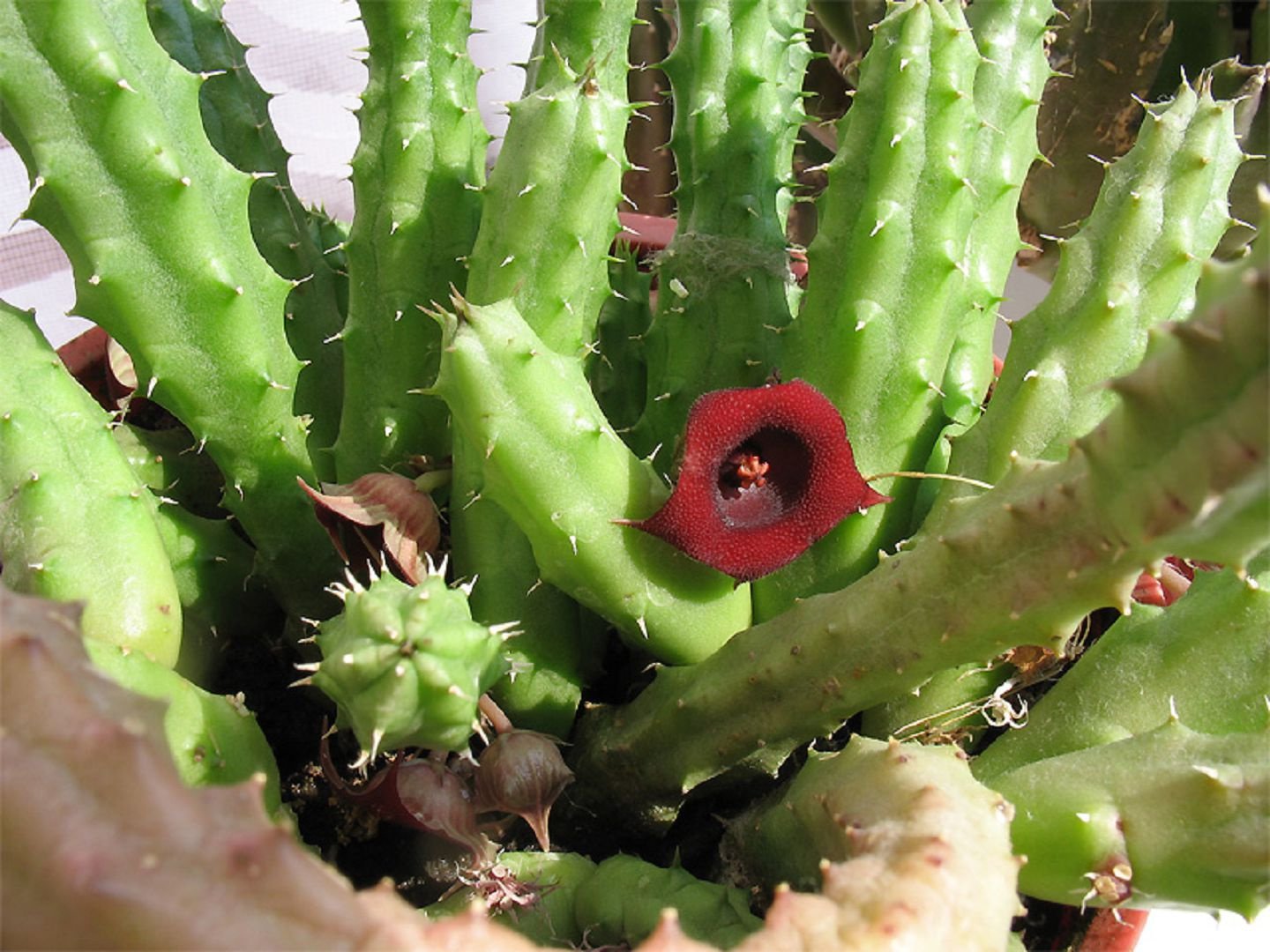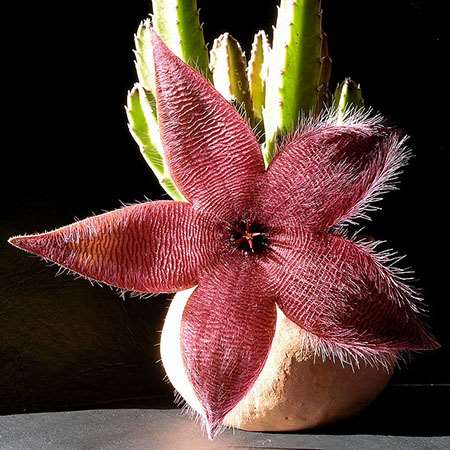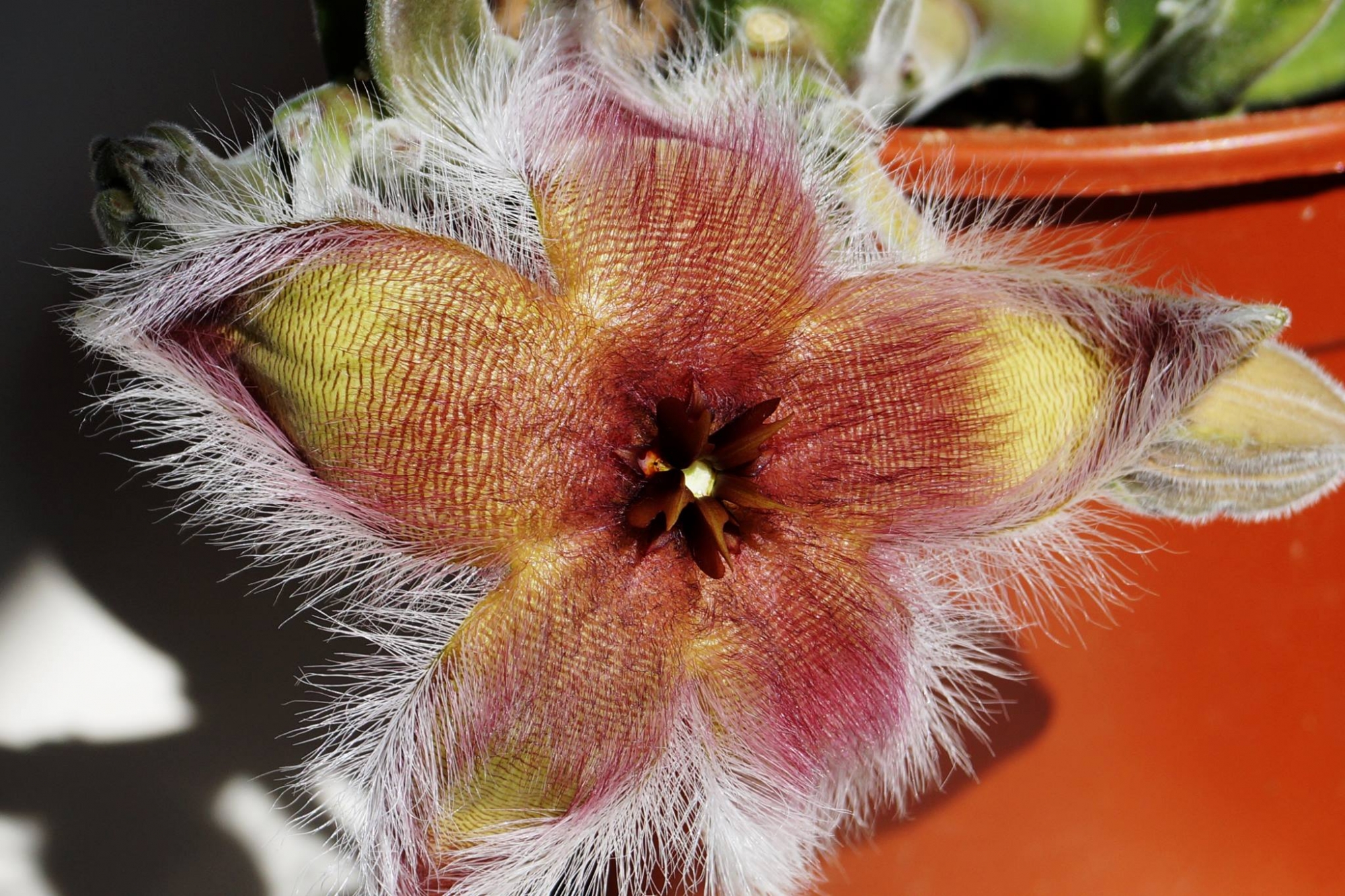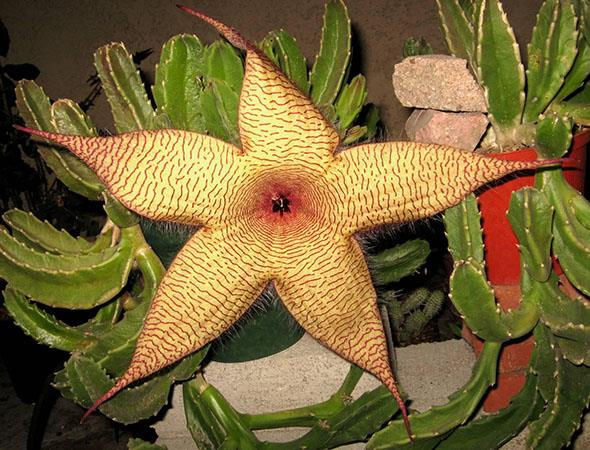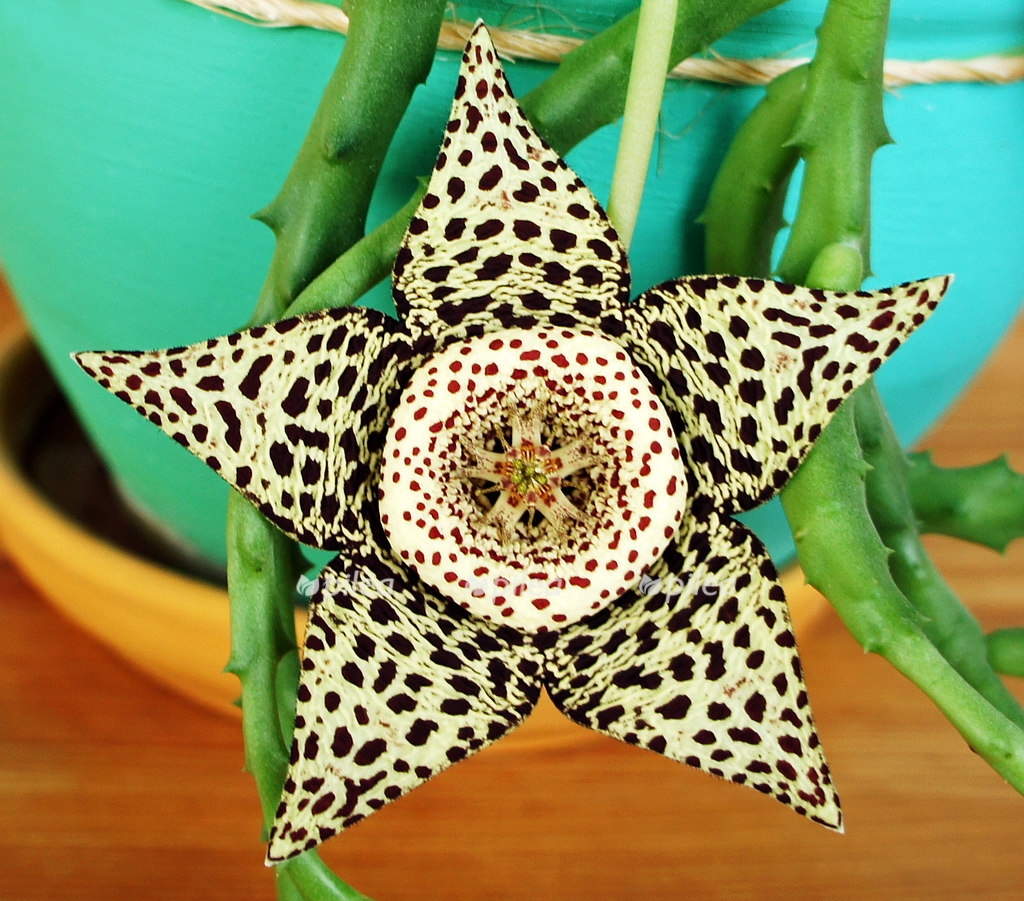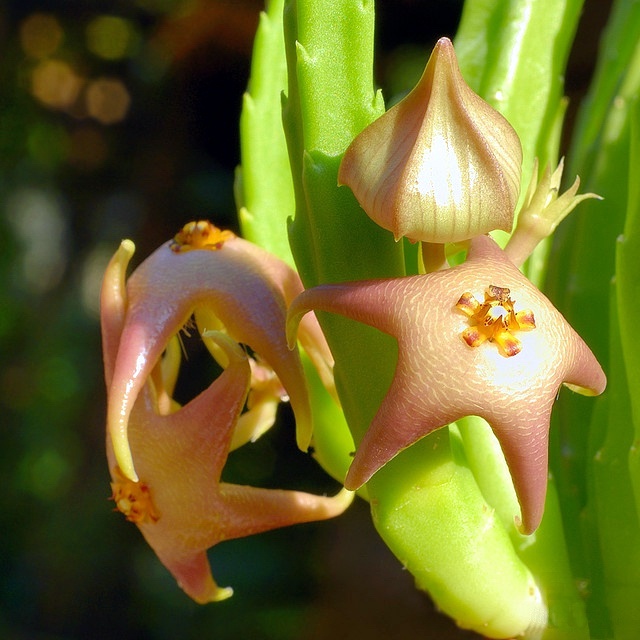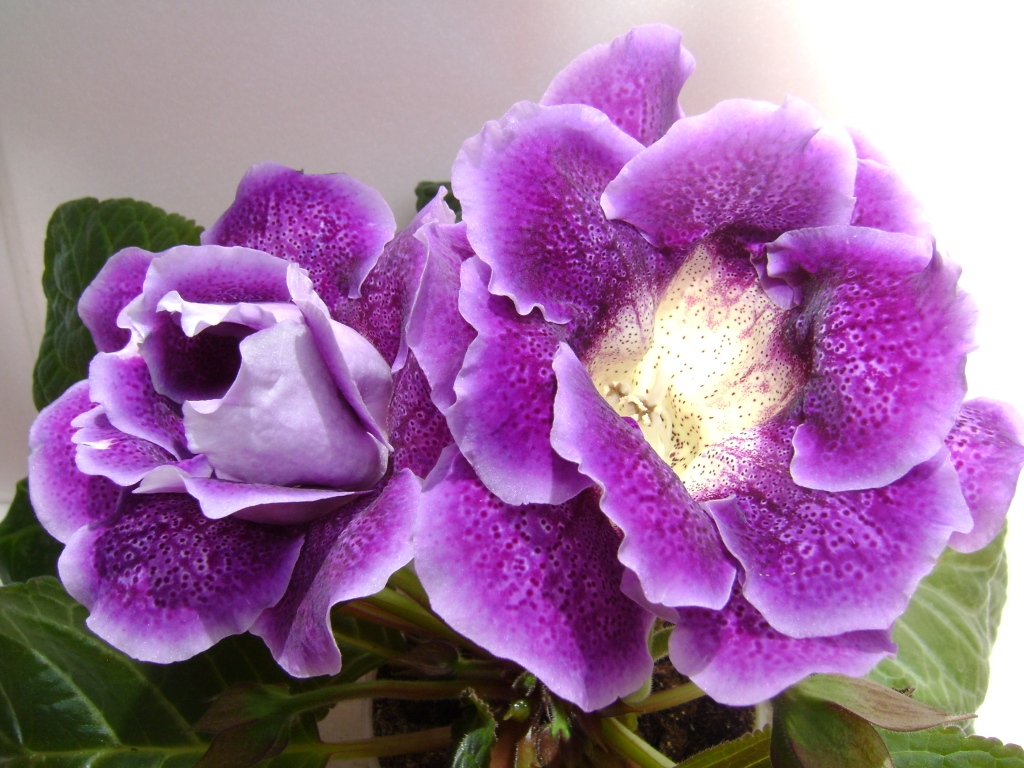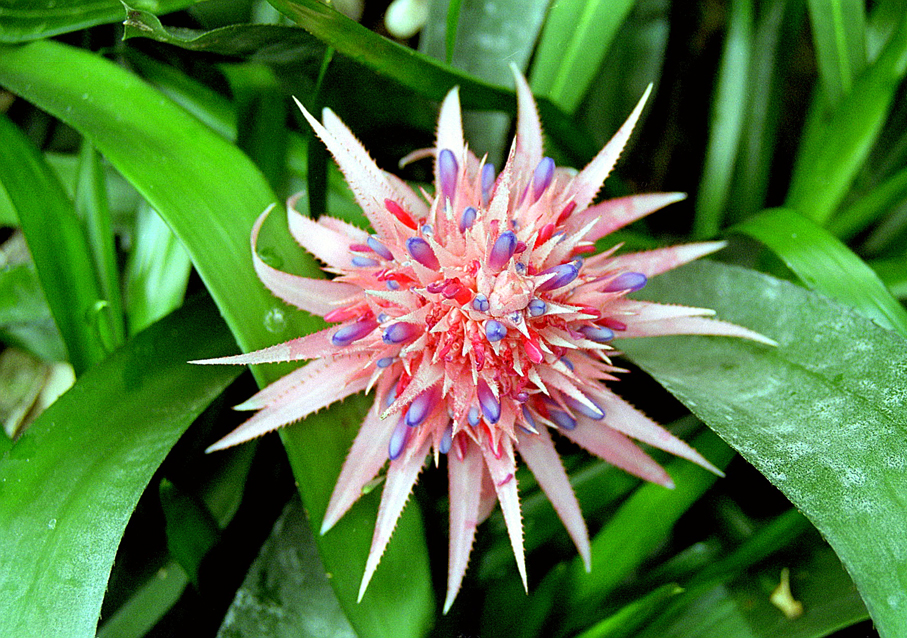Stapelia is an unpretentious houseplant, similar to a cactus, compact, does not require a large amount of soil. Its exotic African character is evident when it blooms. Flowers are unusual and exquisite. Due to the variety of varieties, beauty and originality of flowering, stocks are used in indoor and greenhouse floriculture. Caring for an exotic culture is simple, even a beginner can handle it.
Content
What's interesting about this flower
Stapelia (Stapelia) belong to the Kutrov family, the Lastovnev subfamily. These plants are low-growing shrubs with a height of 10 to 60 cm, consisting of succulent, branching at the very base of stems without leaves.

The stems, as a rule, have a four-sided section, along the edges are equipped with large protruding teeth without thorns. Lateral shoots branching off from the base spread along the ground. The color of the stems is green or silvery-green. In some species, the shoots have reddish or reddish-purple hues that appear in bright sunlight. On young shoots in the lower part of the bush, star-shaped flowers are formed and are from 5 to 30 cm in size in different species. Stapelia flowers are unusual and can have a wide variety of colors: from monochromatic to tiger or leopard. Petals with a smooth leathery glossy or fluffy surface.
Another piquant feature of the stocks' flowers is their smell. Many, but not all, flower species exude a distinct rotten meat smell to varying degrees. This is due to the fact that in natural conditions, carrion flies are the pollinators of these plants.
The natural habitat of the stocks is the desert and semi-desert lands of South and South-West Africa with poor stony arid soils.
Stapels are stem succulents, that is, plants that are capable of storing water in their stems. Despite the similarity in shape with some types of cacti, stocks are not.
The milky juice that the stems contain is poisonous not only to insects. On contact with the skin and mucous membranes, burns or irritation may occur, if ingested, poisoning is possible.
Due to their exoticism, stocks became widespread and even became an object of collecting.
Differences from guernia
No less popular among flower growers are the closest relatives of the stocks, belonging to the same subfamily of the Lastovnevs and originating from the same places as the stocks.
The most similar to the stocks is guernia (Huernia) - a plant whose stems resemble a bush of stocks, but this plant differs from its closest relative by thin-skinned, but thicker stems, more numerous teeth along the edges. Flowers in smell and variety of shapes and shades are also similar to stocks, but much smaller (2-5 cm) and differ in that the petals of the star-shaped crown are accrete and between them there are small projections in the form of a denticle.
Superstition
The blooming slipway is so unusual that popular rumor attributes special qualities to it.
It is believed that it neutralizes negative energy, heals mental wounds, protects the house from damage and the evil eye, as well as from harmful electromagnetic radiation.
The stockpile also affects the relationship of people: it can protect marriage at a young age, but at the same time prevent a girl from marrying, worsen relations and lead to the separation of the spouses.
Believing or not believing in such signs is everyone's business, but everyone must remember the following:
- the smell of a plant can provoke an allergy attack;
- if the milky juice of the staple gets on the skin or mucous membrane, it must be thoroughly washed off;
- under no circumstances should children and / or pets be allowed to taste the plant.
Stock varieties with photos
The following types of stocks are suitable for growing at home:
- large-flowered,
- hirsuta,
- giant,
- grandiflora,
- motley,
- divarikata.
Large-flowered
The plant has stems with medium-sized teeth. The flower, whose diameter reaches 20 cm, is purple on the inside, and blue-green on the outside.
The petals of a pointed shape, covered with gray villi, bend back at the second stage of flowering. There are varieties whose aroma is almost imperceptible.
Hirsuta
This type of plant is distinguished by increased hairiness of flowers, for which it received its name ("hairy"). The hairs are long, have a light shade, densely cover the pointed petals of a flower with a diameter of 5-8 cm.
The smell emitted during flowering is extremely unpleasant. Stems are green, with a typical shape for stocks.
Giant
The stems of the plant have weakly expressed teeth. The flower in the shape of a five-pointed star with sharp ends reaches a diameter of 25 cm. The most common color is light yellow or green with many reddish cross-strokes. Long villi are located along the edges of the petals.
The smell emitted by the flower is quite noticeable.
Motley
This undersized variety has bright green stems up to 10 cm high with sparse teeth. The flowers are also medium-sized - only 8-10 cm, have a flattened shape with a roller around the center. Smooth ovoid-pointed petals, yellow or yellow-brown in color with contrasting spots that have irregular outlines, are collected in small folds closer to the middle of the flower.
Flowers give off a strong smell.
Divarikata
The flowers of this plant variety are about 4 cm in size, have a light coloration, a smooth surface and are odorless.
An interesting feature of such a slipway is the ability of its flower to change its color, acquiring a pinkish tint.
Growing and care
Caring for the slipway at home implies compliance with the following rules:
Growing conditions | Care advice |
Lighting | The lighting should be bright, but not in direct sunlight. In the summer, shading with a light curtain is necessary; in winter this is not required, but additional lighting may be needed. Optimal cultivation on a windowsill facing east or west |
Humidity | The soil in the flower pot by the slipway must be sufficiently moist. The criterion for the need for the next watering is the drying of the top layer of the soil. As the cold season approaches, the frequency of watering should be gradually reduced. The plant does not need spraying |
Temperature | In the spring-summer period, the plant feels comfortable at a temperature of + 22 ... 26 ° С. In winter, during the rest period, this indicator should be reduced to + 14 ... 16 ° С |
Planting and transplanting
The older the plant becomes, the less often it needs a transplant. Young stocks are recommended to be replanted annually - in spring. After reaching the age of three, a plant needs a change of residence less often - once every two to three years.In order to avoid damage to large roots, it is recommended to transplant using the transshipment method. Old plants that have reached large sizes do not need to be transplanted. In this case, it is sufficient to periodically replace the top soil layer in the pot.
Since the root system of the staple is located shallow and extends not so much in depth as in width, it is advisable to choose a pot wide and low. To avoid decay of the roots from waterlogging, it is necessary to drain - up to a third of the volume of the pot.
The soil with which the container is filled should be light, permeable, slightly moistened, containing coarse river sand and turf soil in a 1: 2 ratio with the addition of charcoal. It is also recommended to add sand and charcoal to the substrate purchased in the store for succulents or cacti. Watering after transplanting does not take several days.
Top dressing
It is recommended to apply fertilizers during the growing season twice a month. Experienced growers prefer to focus on potash fertilizers, as they have a beneficial effect on the general condition of the plant, increase its green mass and increase resistance to diseases and pests.
Flowering and resting period
The flowering period lasts from two weeks until the end of the warm period, all summer. Each flower remains decorative for about a week. At this time, it is recommended to avoid waterlogging and feeding the plant.
Preparation for the dormant period begins in the fall, from October. You need to water the flower less and less, once every 2-4 weeks, only slightly moistening the top layer of the earth. The period of complete rest is December and January. At this time, watering should be stopped, and the plant should be transferred to a cool illuminated place where the temperature will not exceed +15 ° С.
The exit from the dormant period is also gradual: from February, you can slightly moisten the soil every 2-4 weeks, then transfer it to a warmer place, and in the spring make the first top dressing.
The plant will feel great without these procedures, but it will not bloom.
Pruning
In the spring, when leaving the dormant period, pruning can be done, removing old stems that have lost their attractive and healthy appearance from the middle of the bush, leaving room for the growth of young shoots: it is on them that the long-awaited buds can appear. The cut sites are processed with crushed activated carbon.
Care errors
The main mistake in caring for the stocks is waterlogging of the soil, as a result of which the root system decays. The stems will become flabby, may turn yellow, and begin to dry. In the initial stage, a transplant with a complete soil replacement will help. When transplanting, without injuring healthy roots, you need to remove the rotten ones, dry the remaining ones well, plant in new soil, do not water for several days. If all the roots have rotted and it is impossible to save the plant, you need to plant several cuttings (see this method below, section "Reproduction").
Drying signs and burns at the ends of the shoots can appear from too much heat. In this case, the plant needs to be shaded.
A minor violation of the irrigation regime, non-observance of the rest period can be considered errors of care. In this case, the plant does not suffer, it simply does not bloom.
Diseases and pests
Stapelia are not very susceptible to diseases and are rarely affected by pests. All diseases of this flower are caused by stagnation of water in the roots. When pests (spider mites or others) appear on the stems, it is recommended to treat the plant with a suitable insecticidal preparation, one of those sold in specialized stores.
Reproduction
Reproduction of stocks can be done in the following ways:
- cuttings,
- seeds.
None of the methods requires special knowledge, it can be carried out at home.
Propagation by cuttings
Staple cuttings are planted immediately in a container with soil.
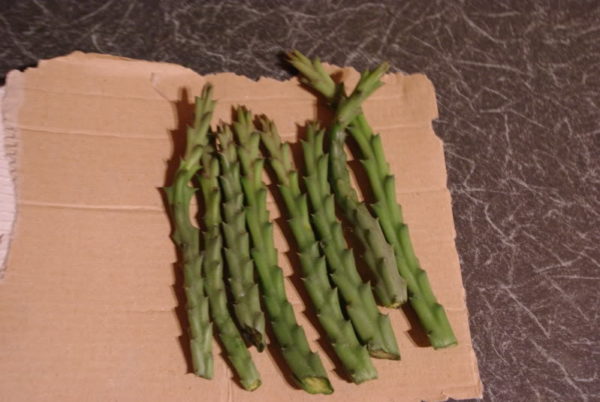
The order of work is as follows:
- With a sterile knife, cut off the top of a healthy staple stem.
- Powder the cut on the mother plant with crushed activated carbon.
- Spread the cuttings in the shade to dry for several hours.
- Plant the cuttings in sand with the addition of peat for rooting.
- After 2-3 weeks, transplant the rooted shoots into small, up to 7-10 cm, pots with prepared soil.
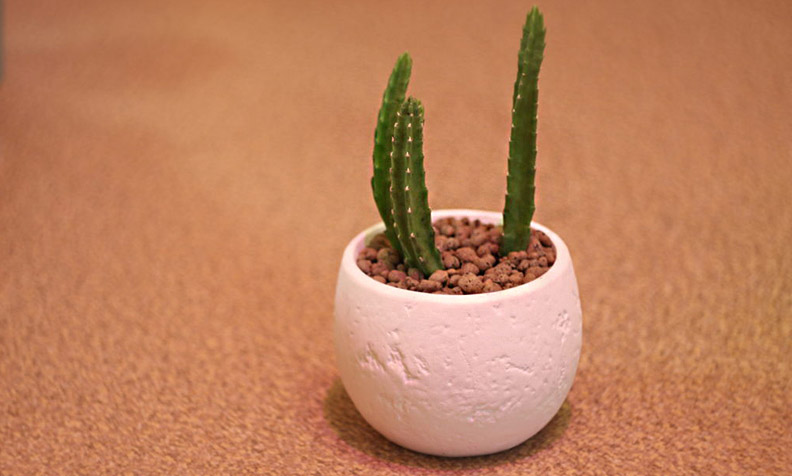
Seed propagation
Propagation by seed staple is applicable in practice, but it should be borne in mind that the new plant is likely to differ significantly from the parent.
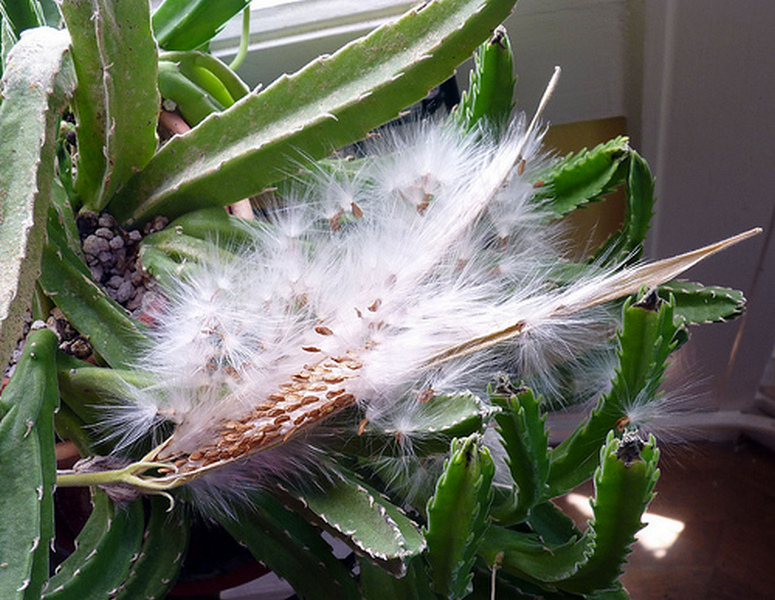
The seeds ripen within a year. Their readiness will be evidenced by a cracked fruit pod and the appearance of seeds with fluffy umbrellas. Fresh material has reliable germination; over time, its percentage decreases.
The further procedure is as follows:
- Sow seeds in light, mostly sandy soil. You will have to wait for seedlings for almost a month.
- Seedlings that have grown up to 2-3 cm are cut out in containers with a diameter of 5-7 cm with normal soil.
- The next transplant into larger pots will be required in a year.

Exotic and elegant flowering stapelia will become an interior decoration and pride of the owner if you take proper care of the plant.
